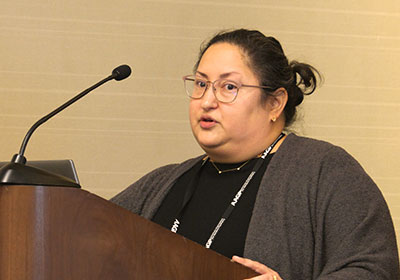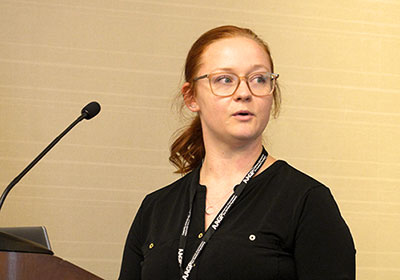Treating Bipolar Disorder in Older Adults Tricky, but Manageable
Abstract
From symptoms to the risk of adverse drug events, bipolar disorder in older adults differs from that in younger adults in myriad ways.
Bipolar disorder carries challenges unique to older patients, said speakers at the American Association for Geriatric Psychiatry 2023 Annual Meeting in New Orleans in March. The presenters, all from the Dell Medical School at the University of Texas at Austin, discussed ways of meeting these challenges in a session titled, “All Mixed Up!! Challenges Faced and Lessons Learned in the Outpatient Management of Bipolar Disorder in Older Adults.”

The growing number of older adults with bipolar disorder mandates treatment recommendations that are tailored to an older population, says Erica Garcia-Pittman, M.D.
Erica Garcia-Pittman, M.D., an associate professor of psychiatry and behavioral sciences, began the session with an overview of bipolar disorder in older adults.
“Of all patients with bipolar disorder, 25% are 60 or older, and this number is expected to increase to 50% in the year 2030 because of the aging of the total population and the greater awareness of bipolar disorder among older adults,” Garcia-Pittman said. “This demographic increase highlights the importance of moving beyond extrapolating treatment recommendations for mixed age groups and instead developing specific recommendations for older adults with bipolar disorder.”
Garcia-Pittman noted several differences between late-onset and early-onset bipolar disorder, in that those with late-onset have the following:
A lower likelihood of a family history of the disorder
Quicker remission
Shorter inpatient stays
Higher rates of vascular and cerebrovascular disease
More vulnerability to the extrapyramidal symptoms (EPS) of antipsychotics and other medications, such as movement disorders
Less frequent psychotic symptoms
Less frequent suicide attempts
More frequent cognitive dysfunction
Sharon Polackal, M.D., a PGY-3 psychiatry resident, discussed the complexities of mixed states of mania and depression in older patients who have bipolar disorder.

When choosing treatments for mixed states in older patients, psychiatrists should keep renal problems and medication affordability in mind, says Sarah Bovio, M.D.
“Distractibility, anxiety, irritability, and agitation—sometimes referred to as the DAIA symptoms—have important implications for mixed states even though they're excluded from the DSM criteria. They are among the most common symptoms in mixed states and they are positively correlated with [bipolar disorder] severity,” Polackal said.
Sarah Bovio, M.D., a PGY-3 psychiatry resident, added that mixed states are “notoriously difficult” to treat and often require dual therapy with a mood stabilizer and an antipsychotic medication for refractory cases.
“Although there is a trend towards mixed states requiring longer treatment courses, choosing the best initial agent involves balancing several factors,” Bovio said. “There are comorbidities, such as cardiac or renal problems, the patient’s existing medications; patient preferences; and affordability.”
Tawny Smith, Pharm.D., an associate professor of psychiatry, offered clinical pearls regarding the use of valproic acid in treating older adults with bipolar disorder.
“Remember that doubling [the] dose of valproic acid doesn’t mean doubling its effect,” Smith said. She explained that older patients have a reduced clearance of valproic acid because of the way they metabolize the medication, which may lead to “higher-than-expected” levels of free valproic acid in the body. To that end, Smith described several situations where psychiatrists should consider ordering tests for levels of free valproic acid in older adults, including when they experience unexplained adverse effects, inadequate clinical response, reduced albumin levels, and/or chronic hepatic disease and renal impairment.
Smith also discussed the treatment of antipsychotic-induced akathisia, a movement disorder in which the patient is unable to remain still.
“The recommended pharmacologic interventions for antipsychotic-induced akathisia may be problematic for older adults with bipolar disorder because of adverse effects, drug contraindications and warnings, and drug interactions,” Smith said. “The best initial approach may be to try to decrease the antipsychotic dose or reduce polypharmacy. Alternately, another option is to switch to another agent that has a lower propensity for antipsychotic-induced akathisia.”
Brian Donley, M.D., M.P.H., a PGY-3 psychiatry resident, discussed drug-induced parkinsonism in older patients with bipolar disorder who have taken cariprazine or other atypical antipsychotics.

Psychiatrists should screen older patients who take atypical antipsychotics for symptoms of developing parkinsonism, says Brian Donley, M.D., M.P.H.
“One of the unique pharmacokinetic features of cariprazine is that it has a relatively long half-life of two to four days by itself. But it also has two active metabolites, one of which has a half-life of two to three weeks rather than days,” Donley explained. Because of this, it may take longer for drug-induced parkinsonism to resolve in older patients who have taken cariprazine, he noted.
Donley added that overall, research has not yet provided a clear and easy answer to questions about how quickly patients develop antipsychotic-induced parkinsonism, or how long it takes to resolve.
“The majority of people seem to recover within a few weeks, although there are case reports of symptoms lasting months,” Donley said. “Generally speaking, we would recommend screening [for parkinsonism] early and often. Usually symptoms will show up pretty quickly, but can be delayed in some people and can take months or even years to develop.”
Robert Good, M.D., a PGY-3 psychiatry resident, discussed ways that COVID-19 could affect renal clearance of lithium in older patients with bipolar disorder, resulting in lithium toxicity.
“Many of the common antivirals used to treat COVID and the antibiotics given for subsequent bacterial pneumonia can cause acute kidney injury,” Good explained. “COVID-19 has [also] has been linked to overactivation of cytokines, which can cause acute kidney injury via circulatory collapse. Rhabdomyolysis, hypercoagulation, respiratory compromise, and hypoxemia [from COVID-19) can also impact renal function.” ■



